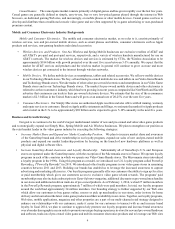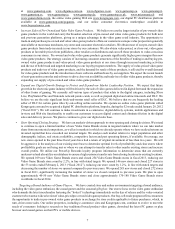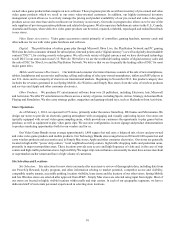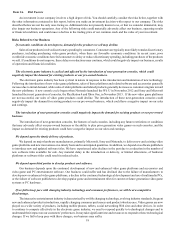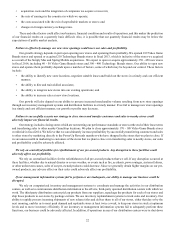GameStop 2013 Annual Report Download - page 33
Download and view the complete annual report
Please find page 33 of the 2013 GameStop annual report below. You can navigate through the pages in the report by either clicking on the pages listed below, or by using the keyword search tool below to find specific information within the annual report.16
Field Management and Staff
Each of our Video Game Brands stores employs, on average, one manager, one assistant manager and between two and ten
sales associates, many of whom are part-time employees. Each store manager is responsible for managing their personnel and the
economic performance of their store. We have cultivated a work environment that attracts employees who are actively interested
in electronic games. We seek to hire and retain employees who know and enjoy working with our products so that they are better
able to assist customers. To encourage them to sell the full range of our products and to maximize our profitability, we provide
our employees with targeted incentive programs to drive overall sales and sales of higher margin products. In certain locations,
we also provide certain employees with the opportunity to take home and try new video games, which enables them to better
discuss those games with our customers. In addition, employees are casually dressed to encourage customer access and increase
the “game-oriented” focus of the stores.
Our stores communicate with our corporate offices daily via e-mail. This e-mail allows for better tracking of trends in
upcoming titles, competitor strategies and in-stock inventory positions. In addition, this electronic communication allows title
selection in each store to be continuously updated and tailored to reflect the tastes and buying patterns of the store’s local market.
These communications also give field management access to relevant inventory levels and loss prevention information and the
opportunity to communicate directly with our executives. We have invested in significant management training programs for our
store managers and our district managers to enhance their business management skills. We also sponsor annual store managers’
conferences at which we operate intense educational training programs to provide our employees with information about the video
game products that will be released by publishers in the holiday season. All video game software publishers are invited to attend
the conferences.
Our U.S. Video Game Brands store operations are managed by four market vice presidents of stores and 30 regional store
operations directors. The regions are further divided into districts, each with a district manager covering an average of 14 stores.
In total, there are approximately 297 districts. Our international operations are managed by a senior executive, with stores in
Europe managed by two senior vice presidents, one vice president and with managing directors in each region. Our stores in
Australia and Canada are each managed by a vice president. We also employ regional loss prevention managers who assist the
stores in implementing security measures to prevent theft of our products.
We operate the Technology Brands stores with a field management and store management structure similar to that of our
Video Game Brands stores. Simply Mac stores operate with a vice president of stores overseeing three district managers, who
supervise between six and ten store managers. Spring Mobile stores are managed by a senior vice president of stores who manages
five regional directors, each of whom manages between two and seven district managers. District managers manage between five
and 12 stores. Aio Wireless stores are managed by a vice president who oversees four regional managers, each of whom manages
a geographic market containing between three and 15 stores.
Customer Service
Our store personnel provide value-added services to each customer, such as maintaining lists of regular customers and
reserving new releases for customers with a down payment to ensure product availability. In addition, our store personnel readily
provide product reviews and ratings to ensure customers are making informed purchasing decisions and inform customers of
available resources, including Game Informer and our e-commerce sites, to increase a customer’s enjoyment of the product upon
purchase.
Vendors
We purchase substantially all of our new products worldwide from over 80 manufacturers, software publishers and several
distributors. Purchases from the top ten vendors accounted for approximately 87% of our new product purchases in fiscal 2013.
As of February 1, 2014, six vendors accounted for greater than 10% of our new product purchases during fiscal 2013. Sony,
Microsoft, Nintendo, Take-Two Interactive, Electronic Arts and Activision accounted for 20%, 15%, 12%, 11%, 10%, and 10%,
respectively. We have established price protections and return privileges with our primary vendors in order to reduce our risk of
inventory obsolescence. In addition, we have few purchase contracts with trade vendors and generally conduct business on an
order-by-order basis, a practice that is typical throughout the industry. We believe that maintaining and strengthening our long-
term relationships with our vendors is essential to our operations and continued expansion. We believe that we have very good
relationships with our vendors.
Competition
The electronic game industry is intensely competitive and subject to rapid changes in consumer preferences and frequent
new product introductions. We compete with mass merchants and regional chains; computer product and consumer electronics
stores; other video game and PC software specialty stores; toy retail chains; direct sales by software publishers; and online retailers


